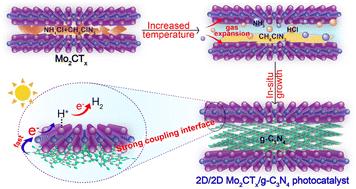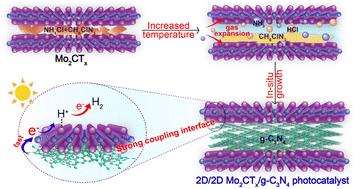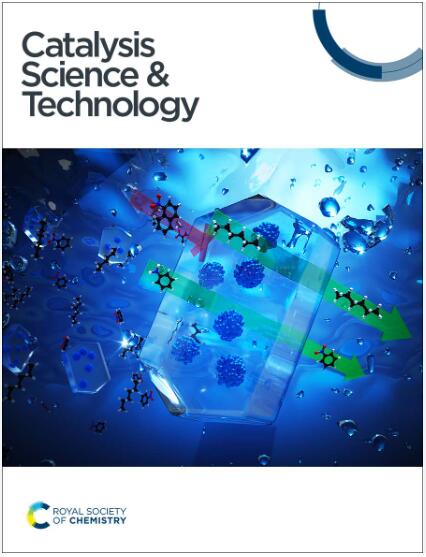通过一步法 NH4Cl 辅助煅烧实现具有强耦合界面的 2D/2D Mo2CTx/g-C3N4,从而提高光催化制氢能力
IF 4.4
3区 化学
Q2 CHEMISTRY, PHYSICAL
引用次数: 0
摘要
Mo2CTx 具有良好的导电性和大量的活性位点,因此被认为是光催化制氢过程中替代贵金属的潜在助催化剂。然而,由于 Mo2CTx 的大块层状结构,传统物理混合法制备的 Mo2CTx 基光催化剂总是显示出 Mo2CTx 与光催化剂之间的弱耦合界面,导致光催化剂的光生电子转移缓慢,从而导致制氢效率不理想。考虑到原位构建和二维/二维结构可以增加接触面积,增强耦合界面相互作用,本研究通过气胀剥离 Mo2CTx 和原位生成 g-C3N4 薄纳米片的方法,采用一步 NH4Cl 辅助煅烧法,实现了以预蚀刻的 Mo2CTx 和盐酸胍(CH6ClN3)为原料构建二维/二维 Mo2CTx/g-C3N4 光催化剂的策略。实验结果表明,二维/二维 Mo2CTx/g-C3N4 复合光催化剂具有优异的 H2 转化活性(125 μmol h-1 g-1,AQE = 3.88%),分别是纯 g-C3N4 和物理混合 Mo2CTx-g-C3N4 的近 25 倍和 18 倍。光催化产生 H2 效率的提高归功于 2D/2D Mo2CTx/g-C3N4 中 Mo2CTx 与 g-C3N4 之间的强耦合界面,它促进了 g-C3N4 向 Mo2CTx 的快速光生电子转移,并实现了最佳吉布斯自由能。这项研究为制备高效的 2D/2D MXene 基光催化剂提供了一个新的视角。本文章由计算机程序翻译,如有差异,请以英文原文为准。


2D/2D Mo2CTx/g-C3N4 with a strong coupling interface via one-step NH4Cl-assisted calcination for enhanced photocatalytic hydrogen production†
Mo2CTx is regarded as a potential cocatalyst to substitute noble metals in photocatalytic hydrogen production owing to its good electrical conductivity and a large number of active sites. However, Mo2CTx-based photocatalysts by the conventional physical mixing method always display a weak coupling interface between Mo2CTx and photocatalysts due to the large block-layered structure of Mo2CTx, which results in slow photogenerated-electron transfer of photocatalysts, thereby leading to unsatisfactory hydrogen production efficiency. Considering that in situ construction and the 2D/2D structure can increase the contact area and enhance the coupling interface interaction, in this study, a strategy of constructing a 2D/2D Mo2CTx/g-C3N4 photocatalyst from pre-etched Mo2CTx and guanidine hydrochloride (CH6ClN3) through a one-step NH4Cl-assisted calcination method is realized by the gas-expansion exfoliation of Mo2CTx and in situ generation of thin g-C3N4 nanosheets. Experimental results unveiled that the 2D/2D Mo2CTx/g-C3N4 composite photocatalyst exhibits an exceptional H2-evolution activity (125 μmol h−1 g−1, AQE = 3.88%), which is almost 25 and 18 times greater than that of pure g-C3N4 and physically mixed Mo2CTx–g-C3N4, respectively. The enhanced photocatalytic H2-production efficiency is attributed to the robust coupling interface between Mo2CTx and g-C3N4 in 2D/2D Mo2CTx/g-C3N4, which promotes the fast photogenerated electron transfer from g-C3N4 to Mo2CTx and achieves an optimized Gibbs free energy. This study offers a novel perspective on preparing high-efficiency 2D/2D MXene-based photocatalysts.
求助全文
通过发布文献求助,成功后即可免费获取论文全文。
去求助
来源期刊

Catalysis Science & Technology
CHEMISTRY, PHYSICAL-
CiteScore
8.70
自引率
6.00%
发文量
587
审稿时长
1.5 months
期刊介绍:
A multidisciplinary journal focusing on cutting edge research across all fundamental science and technological aspects of catalysis.
Editor-in-chief: Bert Weckhuysen
Impact factor: 5.0
Time to first decision (peer reviewed only): 31 days
 求助内容:
求助内容: 应助结果提醒方式:
应助结果提醒方式:


